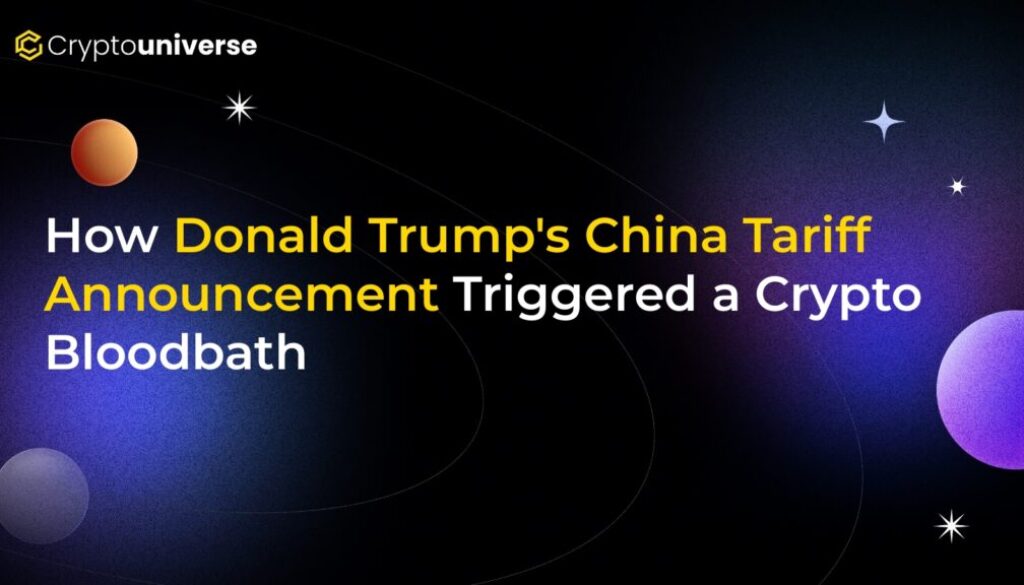How Donald Trump’s China Tariff Announcement Triggered a Crypto Bloodbath

The Unseen Connection: How Global Politics Tanked the Crypto Market
In the world of digital assets, investors often focus on factors like adoption rates, technological upgrades, and network security. Yet, in a stark reminder of crypto’s place in the wider financial ecosystem, a single political announcement sent shockwaves through the market, wiping out billions in value. The event in question was former U.S. President Donald Trump’s China tariff announcement, a move that triggered one of the most volatile trading days the crypto market had seen at the time.
This incident served as a crucial lesson: the crypto market, despite its decentralized ethos, is not an island. It is deeply intertwined with global economics and geopolitical tensions. Let’s break down how a trade dispute between two superpowers caused a digital currency bloodbath.
The Catalyst: A Trade War Escalation
When the Trump administration announced new, sweeping tariffs on Chinese goods, it wasn’t just a political headline; it was a major escalation in the U.S.-China trade war. Traditional markets reacted instantly. The Dow Jones, S&P 500, and other global indices saw a significant downturn as fears of a global economic slowdown intensified.
Investors hate uncertainty, and a trade war between the world’s two largest economies is the epitome of economic uncertainty. The immediate reaction across the board was a flight to safety. But what did this have to do with Bitcoin, Ethereum, and the rest of the crypto world?
A Sea of Red: The Crypto Market’s Reaction
As fear gripped Wall Street, the sentiment quickly spilled over into the crypto markets. The result was a dramatic and sudden sell-off. Within hours of the news breaking, major cryptocurrencies began to nosedive.
- Bitcoin (BTC): The flagship cryptocurrency, often touted as a “safe haven” asset, saw its price plummet, shedding thousands of dollars in value in a single day.
- Ethereum (ETH) & Altcoins: The rest of the market followed suit, with many altcoins experiencing even steeper percentage losses as liquidity dried up.
Billions of dollars in market capitalization vanished, leaving traders and investors stunned. The event challenged the long-held belief that crypto was a non-correlated asset, immune to the whims of traditional finance and politics.
Connecting the Dots: Why Did a Tariff Announcement Crash Crypto?
The connection might not seem obvious at first, but several key economic principles were at play. The crash was not a coincidence but a direct consequence of investor psychology and market mechanics.
1. A Global ‘Risk-Off’ Event
In finance, a “risk-off” environment is when investors become fearful and sell their high-risk, high-reward assets. They then move their capital into safer, more stable assets, known as “safe havens.”
- High-Risk Assets: Stocks, emerging market currencies, and, importantly, cryptocurrencies.
- Safe-Haven Assets: Gold, U.S. Treasury bonds, and the Japanese Yen.
The tariff announcement created a massive risk-off wave. Large institutional investors and everyday traders alike decided to reduce their exposure to volatility. For many, crypto was at the top of the list of assets to sell, leading to immense downward pressure on prices.
2. The Challenge to the ‘Digital Gold’ Narrative
For years, many have championed Bitcoin as “digital gold”—an asset that should hold its value or even appreciate during times of economic turmoil. However, this event showed a different reality. While physical gold prices rallied on the news of the tariffs, Bitcoin’s price moved in lockstep with the stock market. This suggested that, in a true global panic, the broader market still views Bitcoin as a speculative, risk-on asset rather than a reliable store of value.
3. Correlation with Traditional Markets
The incident proved that as more institutional money flows into crypto, its correlation with traditional markets like the S&P 500 increases. The same hedge funds, family offices, and large-scale traders who operate in the stock market are now significant players in crypto. When their risk models tell them to de-risk their entire portfolio, they sell everything, including their crypto holdings. This creates a ripple effect that can drag the entire digital asset market down.
What This Means for Crypto Investors
The key takeaway from the
It’s no longer enough to just follow crypto-specific news. Understanding global trade, central bank policies, and international relations is now crucial for navigating the volatile waters of the crypto market.
While the market has since recovered and evolved, this event remains a powerful case study. It demonstrates that crypto has truly arrived on the global stage, and with that prominence comes exposure to all the complexities and uncertainties of the world economy. For better or for worse, the fate of crypto is tied to the world around it.


